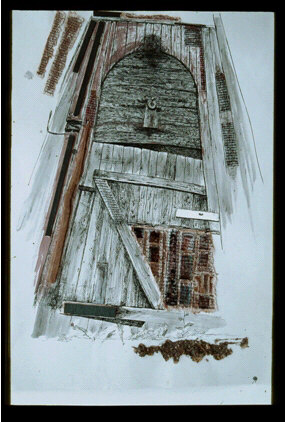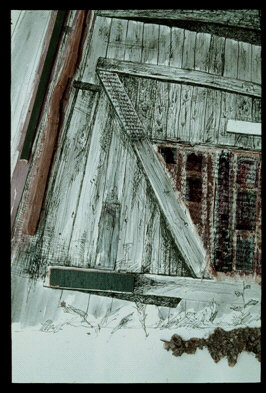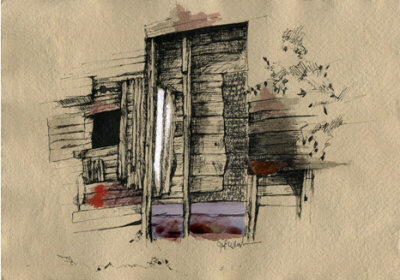 Joyce Ellen Weinstein
Joyce Ellen WeinsteinAlthough the interiors of most of the synagogues have been destroyed, but we can infer the layout. Based on measurements of the building in Kurkliai, technical plans were drawn by Mr. P. Jurenas in 1935. He concluded that the synagogue was divided into two rooms, one slightly larger than the other. The plans indicate a staircase to the women’s balcony. In Kurkliai, as in other villages during the Soviet occupation, the synagogue was also used as a warehouse and storage building for cars, horses, pigs and other animals.
What makes the Kurkliai synagogue remarkable is that the inside has been cleaned. Angele Dudiene, a secondary school teacher, has become the village specialist in Jewish history. She teaches the subject in her classes. A compassionate person with considerable initiative, she took it upon herself to mobilize some of the townspeople and students to help clean up the synagogue. She made the villagers aware of the building as a religious institution. “This,” she says, “is reason enough to restore it.” During the cleaning she found old newspapers and documents, including some unspecified objects that she gave to the Vilna Gaon Jewish State Museum in Vilnius.
It is common for one person in the village to hold the key to the synagogue, sometimes the mayor. Usually, however, the person who holds the key is someone who lives right near the synagogue. In Zeismarai the key is held by an eighty-two year old Russian woman. She was once the caretaker of animals that were stored in the shul by the local veterinarian during the Soviet occupation. She says, “I hold the key because I am such a good person. Ask anyone in the village what a good person I am. They will all tell you this is true.”
 The synagogue in Zeismarai is quite large, with three or four rooms on the lower floor. Although we were able to go inside, it was impossible to tell exactly how many rooms there were. The walls and beams were collapsing, torn down or lying on the ground. Trash was everywhere. There was a second floor but it was completely inaccessible. Because of the size of the structure it can be assumed that the Jews in the village were prosperous. On one of the doors one can make out the silhouette of a mezuzah. According to a Russian friend of mine, the Jews here were not ghettoized but lived all over the town and owned a number of shops. Now, she says, “The synagogue seems to stand more for a monument to the killing of Jews instead of a religious institution.”
The synagogue in Zeismarai is quite large, with three or four rooms on the lower floor. Although we were able to go inside, it was impossible to tell exactly how many rooms there were. The walls and beams were collapsing, torn down or lying on the ground. Trash was everywhere. There was a second floor but it was completely inaccessible. Because of the size of the structure it can be assumed that the Jews in the village were prosperous. On one of the doors one can make out the silhouette of a mezuzah. According to a Russian friend of mine, the Jews here were not ghettoized but lived all over the town and owned a number of shops. Now, she says, “The synagogue seems to stand more for a monument to the killing of Jews instead of a religious institution.”
Because of the curious attitudes of the people we encountered and the uncertainty surrounding the question of the synagogues, I resolved to learn the government’s official position on the subject. I gained easy access to Ms. Diana Varnaite, Director of the Department of Cultural Heritage of Lithuania, and Mr. Alfredas Jomantas, Head of International Cooperation, Department of Cultural Heritage Protection. According to high officials, the government of Lithuania is taking serious steps to raise awareness of the rich cultural heritage left by the Jews, and their important role in Lithuania’s cultural history. According to Ms Varnaite, the launching of cultural tourism, protection of monuments and education are top priorities. She says, “It important to begin now while the material heritage is still in the memories of the people.” But a dilemma remains: if the synagogues are restored, what should they be restored to? What should they become? Some suggestions include multicultural centers, museums or art schools. One village had considered turning its old synagogue into a disco, but was short on funds.
 Although the idea of a discothèque synagogue might seem bazaar, transforming the synagogues into a public attraction might be a pragmatic way to preserve the synagogues and keep them from total collapse. (Granted, a disco hardly seems like the answer.) There are very few Jews left in Lithuania and none who still remain in the villages. The people that do remain (mostly in Vilnius and Kaunas) are not wealthy, so there is almost no money for any kind of reconstruction or care taking. Nevertheless, preserving the buildings would be an important reminder of what once was. It would attach great importance to the legacy of the vibrant cultural heritage of the Jews of Lithuania, once called the Jerusalem of the North. And in a larger sense it would bring to the forefront the recognition by the greater Lithuanian community to the historical value of the wooden synagogues not only for Jews but for Lithuanians as well.
Although the idea of a discothèque synagogue might seem bazaar, transforming the synagogues into a public attraction might be a pragmatic way to preserve the synagogues and keep them from total collapse. (Granted, a disco hardly seems like the answer.) There are very few Jews left in Lithuania and none who still remain in the villages. The people that do remain (mostly in Vilnius and Kaunas) are not wealthy, so there is almost no money for any kind of reconstruction or care taking. Nevertheless, preserving the buildings would be an important reminder of what once was. It would attach great importance to the legacy of the vibrant cultural heritage of the Jews of Lithuania, once called the Jerusalem of the North. And in a larger sense it would bring to the forefront the recognition by the greater Lithuanian community to the historical value of the wooden synagogues not only for Jews but for Lithuanians as well.

Mark Kurlansky's new boogaloo
August, 2005
The new Museum of the American Indian, plus Esther Nussbaum on Yad Vashem
May, 2005
February, 2005
Inside Israel's curious opera ban
May, 2004
August, 2003
Fearing the Germans for the Wrong Reasons
April, 2003
Anxiety on the National Mall
January, 2003



Keri HaRishon
Bruce Lokeinsky
Happy Jew Year
Haya Pomrenze
Ochila La'Eil
Hayes Biggs
The Wooden Synagogues of Lithuania
Joyce Ellen Weinstein
Fetishizing the Trigger
Jay Michaelson
The Goats of War
Jennifer Blowdryer
Archive
Our 760 Back Pages
Zeek in Print
Fall 2005 issue out this month
About Zeek
Mailing List
Contact Us
Subscribe
Tech Support
Links
From previous issues:
Two Incidents at the Cafe Kamienica
Discipline
One Ring Zero: As Smart as They Are
Gordon Haber
Jay Michaelson
Paul Fischer
 Email us your comments
Email us your comments